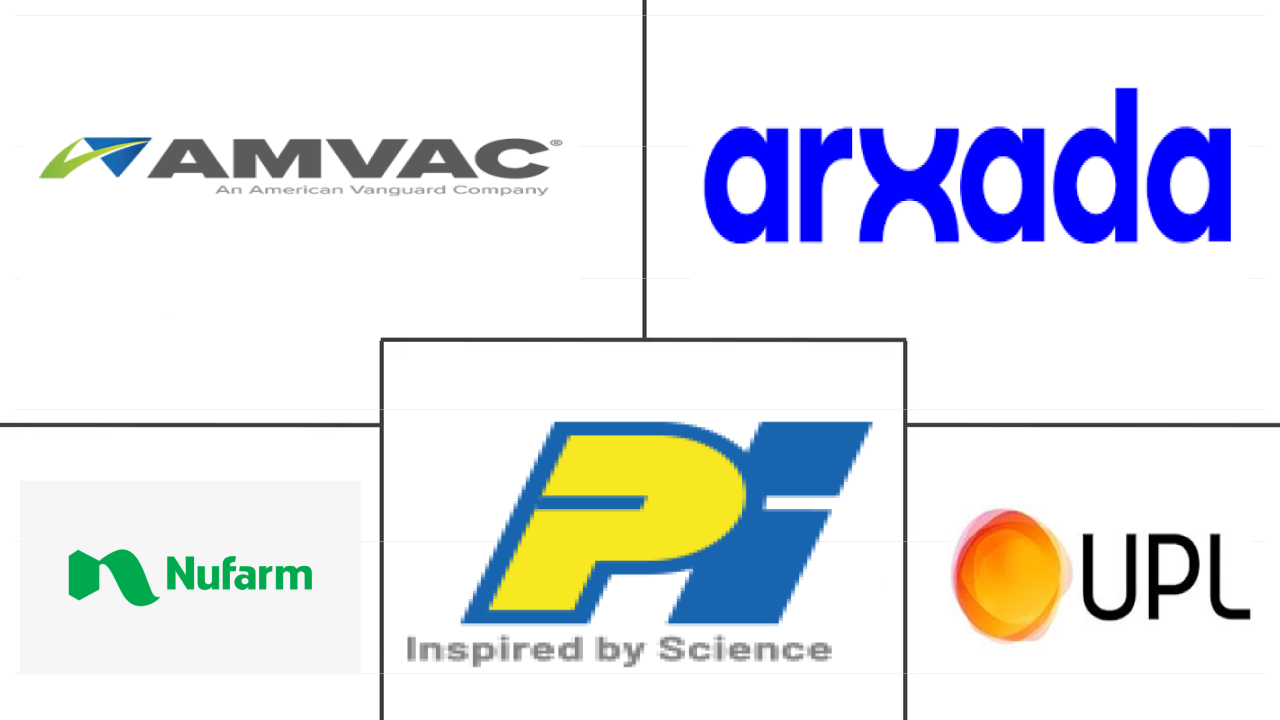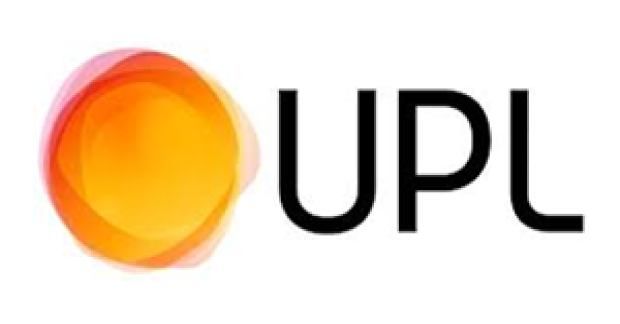Market Size of molluscicide Industry
| Icons | Lable | Value |
|---|---|---|
|
|
Study Period | 2017 - 2029 |
|
|
Market Size (2024) | USD 1.09 Billion |
|
|
Market Size (2029) | USD 1.38 Billion |
|
|
Largest Share by Application Mode | Foliar |
|
|
CAGR (2024 - 2029) | 4.94 % |
|
|
Largest Share by Region | South America |
|
|
Market Concentration | Low |
Major Players |
||

|
||
|
*Disclaimer: Major Players sorted in no particular order |
Molluscicide Market Analysis
The Molluscicide Market size is estimated at 1.09 billion USD in 2024, and is expected to reach 1.38 billion USD by 2029, growing at a CAGR of 4.94% during the forecast period (2024-2029).
1.09 Billion
Market Size in 2024 (USD)
1.38 Billion
Market Size in 2029 (USD)
3.56 %
CAGR (2017-2023)
4.94 %
CAGR (2024-2029)
Largest Segment by Application Mode
54.17 %
value share, Foliar, 2023
The rising snail infestation, particularly in winter and rainy seasons, and the need to improve yield and prevent losses caused by snails are driving the foliar application.
Largest Segment by Crop Type
44.57 %
value share, Grains & Cereals, 2023
Cereal crops can experience yield losses of 50%-90% when infested by snails. Synthetic molluscicides have proven to be more effective in controlling these mollusk populations.
Largest Segment By Region
36.21 %
value share, South America, 2023
Some of the major snails affecting South American crops include the Giant African Snail (Achatina Fulica) and the Golden Apple Snail (Pomacea Canaliculata).
Fastest-growing Segment by Country
8.52 %
Projected CAGR, Brazil, 2024-2029
Brazil dominated the market owing to factors like the increasing snail infestations and yield losses of several economically important crops.
Leading Market Player
18.32 %
market share, UPL Limited, 2022

UPL Limited offers molluscicide products that are stomach-poisonous and suitable for different crop types, including cereals, oilseeds, pulses, vegetables, and fruits.
The demand for molluscicide is driven by increasing snail infestation and rising crop losses
- Globally, the use of molluscicide is expanding in various application modes. Foliar holds the major share value, accounting for 53.7% of the total molluscicide market in 2022. Demand for molluscicides in this segment is driven by increased snail infestation, particularly during the winter and rainy periods, and a need to improve yields and reduce losses due to snails and slugs.
- The demand for molluscicide chemicals in soil treatment methods is expected to register a CAGR of 4.8% during the forecast period (2023-2029) due to the effectiveness of the soil treatment method for molluscicides. The main molluscicide products used for the treatment of soil are metaldehyde, iron phosphate, methiocarb, sodium ferric ethylenediaminetetraacetic acid (EDTA), and niclosamide.
- The chemigation segment in the molluscicide market is expected to grow at 4.6% CAGR from 2023 to 2029. The growth of this segment can be attributed to an increased area under drip irrigation systems, as well as a growing trend of the use of chemicals against snails or slugs using water management on these crops.
- The fumigation method's market value is expected to increase by USD 7.1 million during the forecast period (2023-2029). The market growth is expected to be stimulated by a growing awareness of the economic losses from mollusk damage in farmers and agricultural professionals, as well as the rising adoption of fumigation.
- Therefore, factors such as rising snail infestation, the growing area under irrigation, and increasing crop losses are driving the demand for molluscicide. The global molluscicide market is expected to grow at 4.9% CAGR during the forecast period from 2023 to 2029.
South America dominated the global molluscicide market
- Crop damage caused by slugs and snails can lead to a significant loss in crop yield as well as a negative economic impact on farmers. Consequently, the demand for effective molluscicides that are capable of targeting snails and protecting crops from damage is increasing.
- South America dominated the global molluscicide market, accounting for a market share of 36.2% in 2022. Some of the major snails that affect agriculture in South American countries include the giant African snail (Achatina fulica) and the golden apple snail (Pomacea canaliculata). These invasive species are known for their voracious appetite and ability to rapidly reproduce, posing a serious threat to various crops. The yield losses caused by these snails can be substantial, with crops like rice, corn, and vegetables being particularly vulnerable. The snails feed on young seedlings, foliage, and even mature plants, leading to reduced crop quality and quantity.
- Asia-Pacific accounted for the second-largest market share of 26.0% in 2022. Snail farming failed in Asia because snails were destroying the growing rice crops, which caused them severe economic consequences as rice farms were considered their most significant source of food and farm income. The golden apple snail, Pomacea canaliculata, had been introduced to several Asian countries, where it unexpectedly developed into a pest for rice crops. Most farmers have resorted to chemical control, which includes the use of molluscicides, and have also resorted to integrated snail management practices.
- The increasing snail and slug infestations in major crops will drive the molluscicides market globally, which is anticipated to register a CAGR of 4.9% during the forecast period (2023-2029).
Molluscicide Industry Segmentation
Chemigation, Foliar, Fumigation, Soil Treatment are covered as segments by Application Mode. Commercial Crops, Fruits & Vegetables, Grains & Cereals, Pulses & Oilseeds, Turf & Ornamental are covered as segments by Crop Type. Africa, Asia-Pacific, Europe, North America, South America are covered as segments by Region.
- Globally, the use of molluscicide is expanding in various application modes. Foliar holds the major share value, accounting for 53.7% of the total molluscicide market in 2022. Demand for molluscicides in this segment is driven by increased snail infestation, particularly during the winter and rainy periods, and a need to improve yields and reduce losses due to snails and slugs.
- The demand for molluscicide chemicals in soil treatment methods is expected to register a CAGR of 4.8% during the forecast period (2023-2029) due to the effectiveness of the soil treatment method for molluscicides. The main molluscicide products used for the treatment of soil are metaldehyde, iron phosphate, methiocarb, sodium ferric ethylenediaminetetraacetic acid (EDTA), and niclosamide.
- The chemigation segment in the molluscicide market is expected to grow at 4.6% CAGR from 2023 to 2029. The growth of this segment can be attributed to an increased area under drip irrigation systems, as well as a growing trend of the use of chemicals against snails or slugs using water management on these crops.
- The fumigation method's market value is expected to increase by USD 7.1 million during the forecast period (2023-2029). The market growth is expected to be stimulated by a growing awareness of the economic losses from mollusk damage in farmers and agricultural professionals, as well as the rising adoption of fumigation.
- Therefore, factors such as rising snail infestation, the growing area under irrigation, and increasing crop losses are driving the demand for molluscicide. The global molluscicide market is expected to grow at 4.9% CAGR during the forecast period from 2023 to 2029.
| Application Mode | |
| Chemigation | |
| Foliar | |
| Fumigation | |
| Soil Treatment |
| Crop Type | |
| Commercial Crops | |
| Fruits & Vegetables | |
| Grains & Cereals | |
| Pulses & Oilseeds | |
| Turf & Ornamental |
| Region | |||||||||||||||
| |||||||||||||||
| |||||||||||||||
| |||||||||||||||
| |||||||||||||||
|
Molluscicide Market Size Summary
The molluscicide market is experiencing significant growth, driven by the increasing need to combat snail and slug infestations that threaten agricultural productivity. The market is characterized by a diverse range of application methods, with foliar treatments holding the largest share due to their effectiveness in addressing infestations during critical periods. The demand for soil treatment methods is also on the rise, supported by the efficacy of products like metaldehyde and iron phosphate. Additionally, the chemigation segment is expanding, fueled by the adoption of drip irrigation systems and water management practices. The market's growth is further bolstered by heightened awareness of the economic impact of mollusk damage, prompting farmers and agricultural professionals to adopt more effective control measures.
Regionally, South America leads the market, significantly impacted by invasive species such as the giant African snail and the golden apple snail, which pose substantial threats to crops like rice and corn. The Asia-Pacific region follows, where the introduction of the golden apple snail has led to severe economic consequences for rice farmers. Europe and North America also contribute to the market, with varying levels of molluscicide consumption per hectare. The market is fragmented, with major players like American Vanguard Corporation and Arxada holding significant shares. Recent strategic acquisitions and mergers, such as those by Mitsui & Co. Ltd, aim to strengthen market positions and expand product offerings in the European crop protection sector.
Molluscicide Market Size - Table of Contents
-
1. MARKET SEGMENTATION (includes market size in Value in USD and Volume, Forecasts up to 2029 and analysis of growth prospects)
-
1.1 Application Mode
-
1.1.1 Chemigation
-
1.1.2 Foliar
-
1.1.3 Fumigation
-
1.1.4 Soil Treatment
-
-
1.2 Crop Type
-
1.2.1 Commercial Crops
-
1.2.2 Fruits & Vegetables
-
1.2.3 Grains & Cereals
-
1.2.4 Pulses & Oilseeds
-
1.2.5 Turf & Ornamental
-
-
1.3 Region
-
1.3.1 Africa
-
1.3.1.1 By Country
-
1.3.1.1.1 South Africa
-
1.3.1.1.2 Rest of Africa
-
-
-
1.3.2 Asia-Pacific
-
1.3.2.1 By Country
-
1.3.2.1.1 Australia
-
1.3.2.1.2 China
-
1.3.2.1.3 India
-
1.3.2.1.4 Indonesia
-
1.3.2.1.5 Japan
-
1.3.2.1.6 Myanmar
-
1.3.2.1.7 Pakistan
-
1.3.2.1.8 Philippines
-
1.3.2.1.9 Thailand
-
1.3.2.1.10 Vietnam
-
1.3.2.1.11 Rest of Asia-Pacific
-
-
-
1.3.3 Europe
-
1.3.3.1 By Country
-
1.3.3.1.1 France
-
1.3.3.1.2 Germany
-
1.3.3.1.3 Italy
-
1.3.3.1.4 Netherlands
-
1.3.3.1.5 Russia
-
1.3.3.1.6 Spain
-
1.3.3.1.7 Ukraine
-
1.3.3.1.8 United Kingdom
-
1.3.3.1.9 Rest of Europe
-
-
-
1.3.4 North America
-
1.3.4.1 By Country
-
1.3.4.1.1 Canada
-
1.3.4.1.2 Mexico
-
1.3.4.1.3 United States
-
1.3.4.1.4 Rest of North America
-
-
-
1.3.5 South America
-
1.3.5.1 By Country
-
1.3.5.1.1 Argentina
-
1.3.5.1.2 Brazil
-
1.3.5.1.3 Chile
-
1.3.5.1.4 Rest of South America
-
-
-
-
Molluscicide Market Size FAQs
How big is the Global Molluscicide Market?
The Global Molluscicide Market size is expected to reach USD 1.09 billion in 2024 and grow at a CAGR of 4.94% to reach USD 1.38 billion by 2029.
What is the current Global Molluscicide Market size?
In 2024, the Global Molluscicide Market size is expected to reach USD 1.09 billion.

